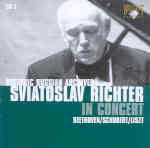Although the works in this five-disc collection are not new to Sviatoslav Richter’s vast discography, many performances appear for the first time in general circulation, as opposed to independent, limited-edition releases. Richter was more consistent than his acolytes often claim, so generally you’ll encounter no major interpretive differences between the live Moscow performances here and their contemporaneous counterparts on Praga, Philips, and BBC. The sound quality varies from venue to venue. Loud moments turn flinty in the closely engineered January 12, 1975 program encompassing Beethoven’s C major Op. 2 No. 3, E-flat Op. 7, and C minor Op. 111 sonatas, but they sound more reverberant and less fatiguing in the present transfers than as heard in a four-disc Music and Arts Richter compilation (M&A 775). I especially like the C major sonata Scherzo’s pinpointed articulation and careful dynamic gradations, as well as the fiery abandon Richter brings to Op. 111’s first movement.
Richter inflects the opening movements of Op. 90 and Op. 101 more freely in 1965 in comparison to his relatively starker later versions (the 1970 studio Op. 90 on Olympia, and the 1986 Op. 101 on Praga), although the younger Richter proves more nimble in regard to balancing the gnarly dotted rhythms in Op. 101’s march movement. A faulty tape transfer renders the latter’s first chord off pitch, whereas a private Russian Masters edition of this performance (minus the first movement) avoids this glitch and boasts fuller sound. The two Op. 31 sonatas confirm what we know from other Richter versions: a more lyrical, introspective take on the “Tempest” sonata’s outer movements, and incandescent fingerwork in the E-flat (especially in the gallopping Finale).
My positive comments vis-à-vis Richter’s 1966 Aldeburgh Festival Liszt Sonata apply to a previously unreleased October 12, 1965 Moscow performance. It’s not so well recorded nor technically secure as the 1966 Livorno version included in Philips’ Richter Edition, yet Richter’s sensitive, powerfully projected conception still comes through. In 1961, Richter’s customary slow-motion treatment of the Schubert B-flat sonata’s lengthy first movement flowed more gracefully than his relatively stark and severe 1972 revists (both live and in the studio), even if the Scherzo and Finale are a shade brisk and breathless.
Fine though the Schubert B major may be (it stems from the same concert as the Liszt sonata), Richter’s interpretation grew more settled and poised within a year, as both the 1966 Philips and Music & Arts readings bear out. However, I prefer the expressive economy of Richter’s May, 1978 Schubert E minor to his earlier, looser Aldeburgh performance on BBC. From the same concert, Schubert’s G major sonata benefits from slightly faster tempos and a greater sense of the music’s overall line, compared to the better engineered live 1989 London performance in Philips’ Richter Edition. Sonic reservations aside, all serious Richter mavens should acquire this release. Its slim packaging won’t gobble up shelf space, and its super-budget price won’t strain the wallet.
































